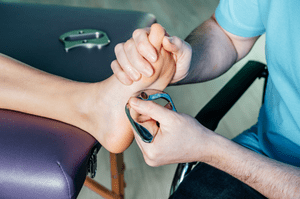Introduction:
Struggling with foot pain? Plantar fasciitis might be the culprit. Often overlooked, its roots lie not in footwear but in pelvic imbalances, leading to strain on the feet.
Key Takeaway:
- Plantar fasciitis often stems from pelvic imbalances, not footwear.
- Treatments like spinal orthotics and physical therapy address root causes effectively.
- Seek comprehensive evaluation and tailored treatment for lasting relief.
What are effective treatments for plantar fasciitis?
Effective treatments for plantar fasciitis include addressing underlying pelvic imbalances through spinal orthotics and functional physical therapy, which focus on restoring proper body alignment and strengthening muscles to alleviate foot pain.
If you suffer pain in the soles or heels of your feet when standing or walking, you may well be suffering from plantar fasciitis. If you are in middle age or you spend a lot of time on your feet, the band of ligament (plantar fascia) connecting your heel bone to your toes can become strained, resulting in plantar fasciitis. Just like many other conditions though, plantar fasciitis doesn’t just happen, somewhere there is an underlying cause. As unlikely as it may sound, one of the most common causes of plantar fasciitis lies further up your body, in your pelvis and hips.
It’s All in the Hips
When we begin to suffer pain in our feet, especially pain which starts when standing or walking, the first thing we are likely to look at is our shoes. Are they a poor fit? Are they poor quality? Very often though, the cause of plantar fasciitis is a pelvic imbalance which causes one side of our hips to be higher than the other. This imbalance in turn causes weight to be distributed unevenly on our feet, subjecting the arches to massive levels of strain.
Plantar fasciitis develops when all this strain on your feet results in the plantar fascia developing small tears and becoming inflamed. That’s when the foot pain begins. If left untreated the pain can become chronic, making it uncomfortable to stand or walk for any period of time.
The Causes of Unbalanced Hips:
Again, hip or pelvic imbalances don’t just happen. There is a cause behind everything. In this case the cause is usually our modern lifestyle which so often denies the body of the natural movement and exercise which it has been built for. Humans are designed by nature to spend a lot of time on our feet. Our bodies are engineered to travel and hunt for food and what’s more; we are engineered to do so barefoot.
Modern living is much more sedentary though and we spend a lot of time sitting, which in itself can result in the hips becoming unbalanced. In turn, our gait changes so when we walk, we place all this extra strain on our feet. Therefore, to treat the foot problem, we need to address the problem with the hips and pelvis.
Effective Treatments for Plantar Fasciitis:
Rather than turning to pain medication, which purely masks the symptoms of plantar fasciitis and meanwhile allows the condition to progress, it’s important to address the imbalance in your body that’s causing the pain in your feet. Two very effective ways to treat the problem are the use of spinal orthotics and receiving treatment in the form of functional physical therapy.
Spinal orthotic devices are stabilizing inserts which you wear inside your shoes to support the arches of your feet and control the way in which the feet move. When you use these “stabilizers” your posture and gait are normalized. As well as supporting the architecture of your feet, orthotic devices help to correct any pelvic imbalance, promoting a return of your body to its correct alignment and therefore alleviating the problems which cause plantar fasciitis
There are a number of key benefits from using orthotics in the plantar fasciitis treatment. Namely; the provision of fast relief from pain in the heel, ankle or foot arches, immediate improvement in leg and foot function and of course the fact that the treatment is conservative and non-invasive. The treatment is most effective when used in combination with other forms of conservative treatment: functional physical therapy in particular.
The Role of Physical Therapy:
Along with orthotics, functional physical therapy, a form of physical therapy which combines hands-on manual manipulation with targeted exercises has proven to be very effective in treating plantar fasciitis. Functional physical therapy is concerned with correcting the musculoskeletal imbalances which can result in or from poor posture and gait. A program of functional physical therapy will consist of the following elements:
- Restoring your correct body alignment.
- Strengthening and retraining your muscles to help your body maintain alignment.
- Engaging you in targeted exercises to improve your alignment and to reduce stiffness and tension in your plantar fascia.
Your therapist will apply various hands-on treatments which might include joint manipulation, myofascial stripping and soft tissue mobilization to relieve your foot pain and promote healing. He or she will also encourage you to take ownership of your treatment by providing advice about lifestyle, exercise and other methods of self-care.
Begin With a Postural Evaluation at OCWP:
If you are currently treating your plantar fasciitis with medication or undergoing clinical treatment such as painful corticosteroid injections, there are more effective, safer and more permanent ways to address your condition.
At Orange County OC Wellness Physicians Medical Center, we will start by conducting a postural evaluation to determine if a pelvic imbalance is at the root of your foot pain. We will then prescribe the most appropriate treatment including, if necessary, stabilizing orthotics. Our physical therapists practice at the forefront of conservative treatment techniques and can quickly set you on a path to improved mobility and freedom from pain. It’s easy to schedule an appointment with us online or you can speak to us directly by phoning (657) 837-2657.
Recent Blogs
Why Physical Therapy Should Be Your Secret Weapon Before Surgery
Surgery, while sometimes necessary, can be a daunting prospect. The recovery process is often lengthy and filled with unknowns. But what if there was a way to optimize your body's readiness for surgery and [...]
Spinal Decompression Therapy: A Non-Surgical Option for Herniated Discs
The discs in your spine act as cushions between the vertebrae, providing flexibility and absorbing shock. When the outer wall of a disc weakens or tears, the soft inner core can bulge or push [...]
PRP for Knees_ A Promising Option for Pain Relief and Mobility – word
For many people, knee pain is a constant companion, limiting mobility and impacting quality of life. Traditional treatments like pain medication and physical therapy can offer relief, but they may not address the underlying [...]





